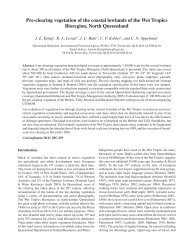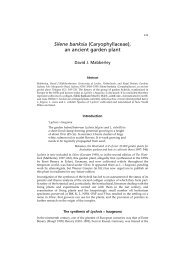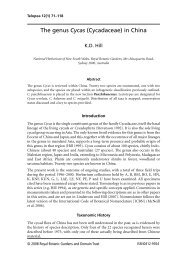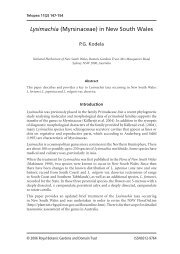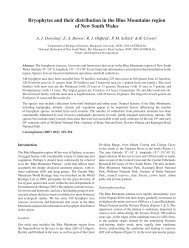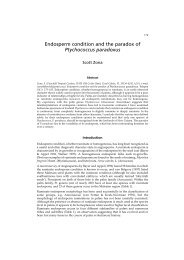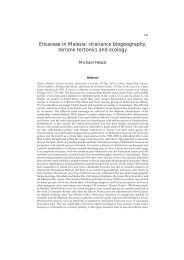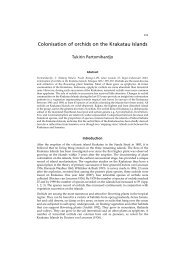Full paper - Royal Botanic Gardens & Domain Trust - NSW ...
Full paper - Royal Botanic Gardens & Domain Trust - NSW ...
Full paper - Royal Botanic Gardens & Domain Trust - NSW ...
Create successful ePaper yourself
Turn your PDF publications into a flip-book with our unique Google optimized e-Paper software.
Cunninghamia 12(4): 2012 Westbrooke, Gowans& Gibson, Vegetation of Paroo Darling National Park, western New South Wales 353<br />
Distribution of communities<br />
Floristically, the Mount Murchison and Wilga areas could be<br />
considered contiguous if not separated by the Darling River.<br />
The distribution and species composition of vegetation<br />
communities within Paroo Darling National Park is largely<br />
determined by variation in topography, landform position<br />
and soil type. Eucalyptus species open woodlands are<br />
associated with texture contrast soils of the major creeklines<br />
and on clays around the overflow lakes. Woodlands variously<br />
dominated by Casuarina pauper and Flindersia maculosa<br />
occur on desert loams and mixed herblands occur on the<br />
clays associated with the floodplains of the Darling River.<br />
Maireana pyramidata low open shrubland occurs on the<br />
sandplains. Other factors, notably past grazing history, have<br />
also played a role in determining the present distribution and<br />
floristic composition of the communities present.<br />
Vegetation condition<br />
Whilst this was not intended to be a detailed assessment<br />
of vegetation condition, regeneration of overstorey and<br />
perennial understorey species was noted. Species richness<br />
and weediness are additional factors which give some<br />
measure of vegetation condition. The communities of the<br />
Mount Murchison area are overall in good condition despite<br />
the history of grazing management. It suggests that this<br />
part of the Park has previously been subject to a relatively<br />
conservative grazing regime. Grazing pressure for the Wilga<br />
area appeared to be elevated towards the homestead and<br />
holding paddocks, however it is moderate to low over much<br />
of the remaining area.<br />
Conservation status of vegetation communities<br />
The communities mapped largely correspond to those<br />
listed by Benson (1989), Benson (2006), Benson (2008)<br />
and Benson et al. (2010). Table 5 shows the threat category<br />
of communities based on Benson et al. (2010). Nine of<br />
the communities recorded have a threat category of Near<br />
Threatened, Vulnerable or Endangered. Benson et al. (2010)<br />
has allocated threatened categories which are based on a<br />
number of sources including the guidelines for nominating<br />
ecological communities under the Commonwealth EPBC<br />
Act (Benson 2006).<br />
Eucalyptus coolabah / Eucalyptus largiflorens open<br />
woodland is listed as an endangered ecological community<br />
under the Commonwealth Environment Protection and<br />
Biodiversity Conservation Act 1999 (EPBC Act) and the<br />
<strong>NSW</strong> Threatened Species Conservation Act 1995 (TSC<br />
Act). Under the EPBC Act, the community is referred to as<br />
Coolibah - Black Box Woodlands of the Darling Riverine<br />
Plains and the Brigalow Belt South Bioregions and under the<br />
TSC Act, the community is referred to as Coolibah-Black<br />
Box Woodland in the Darling Riverine Plains, Brigalow<br />
Belt South, Cobar Peneplain and Mulga Lands Bioregion.<br />
This endangered ecological community is known to be<br />
associated with the following Benson et al. (2010) vegetation<br />
communities:<br />
Black Box woodland on <strong>NSW</strong> central and northern<br />
floodplains including the DRP and BBS Bioregions<br />
(ID No. 37);<br />
Coolabah – River Coobah – Lignum woodland of<br />
frequently flooded floodplains mainly in the Darling<br />
Riverine Plains Bioregion (ID No. 39); and<br />
Coolabah open woodland with chenopod/grassy<br />
ground cover on grey and brown clay floodplains (ID<br />
No. 40).<br />
The Benson et al. (2010) threat categories for these vegetation<br />
communities associated with the endangered ecological<br />
community are outlined in Table 5. Keith et al. (2009)<br />
determined that around 60% of the community had been<br />
lost since European settlement and that the rate of loss had<br />
increased in recent years. That which remains is increasingly<br />
fragmented (NFRPC 2004). Further to clearing other key<br />
threats to the endangered ecological community include<br />
hydrological changes and altered water flow and flooding<br />
regimes (including inundation duration), inappropriate<br />
grazing regimes and invasion by weeds (Benson 2006;<br />
Benson 2008; Benson et al. 2010; TSSC 2011; Keith et al.<br />
2009). A major threat to the Eucalyptus camaldulensis open<br />
woodland community, a related floodplain community, has<br />
been and continues to be also a reduction in flooding regimes<br />
(Benson 2006; Benson 2008; Benson et al. 2010).<br />
Almost all of the communities recorded for Mount<br />
Murchison and Wilga are susceptible to and threatened<br />
by grazing pressure (Benson 2006; Benson 2008; Benson<br />
et al. 2010). Grazing threatens the regeneration of many<br />
palatable plant species associated with these communities<br />
which ultimately alters the floristic diversity and structure<br />
of the community (Benson 2006; Benson 2008; Benson et<br />
al. 2010). There is general concern for communities such as<br />
Casuarina pauper / Alectryon oleifolius low open woodland<br />
(Westbrooke 2005; Benson 2006), Hakea leucoptera tall<br />
open shrubland (Westbrooke 1998),Atalaya hemiglauca<br />
low open woodland, , Eucalyptus coolabah / E. largiflorens<br />
open woodland, Acacia aneura tall open shrubland, and<br />
Acacia ligulata tall open shrubland occurs (Benson 2006;<br />
Benson 2008; Benson et al. 2010)and for example where key<br />
species may die off unless recruitment. A number of these<br />
woodland communities such as Atalaya hemiglauca low<br />
open woodland, Casuarina pauper / Alectryon oleifolius low<br />
open woodland, Flindersia maculosa low open woodland<br />
and Hakea leucoptera tall open shrubland are regarded<br />
as near threatened largely due to past timber harvesting/<br />
thinning/clearing and lack of regeneration (Benson et al.<br />
2010). Atalaya hemiglauca low open woodland may become<br />
vulnerable if recruitment of key species does not occur<br />
(Benson et al. 2010). Acacia victoriae open shrubland is<br />
likely to be a derived community as a result of the Callitris<br />
being removed in the past from timber cutting (Benson et<br />
al. 2010). Callitris glaucophylla seedlings are known to be<br />
intolerant of grazing, palatable and very slow growing in the<br />
early stages (Westbrooke 1998) which may partly explain<br />
why following this disturbance, there is a lack of recruitment<br />
and a gradual loss of this species from this community.





